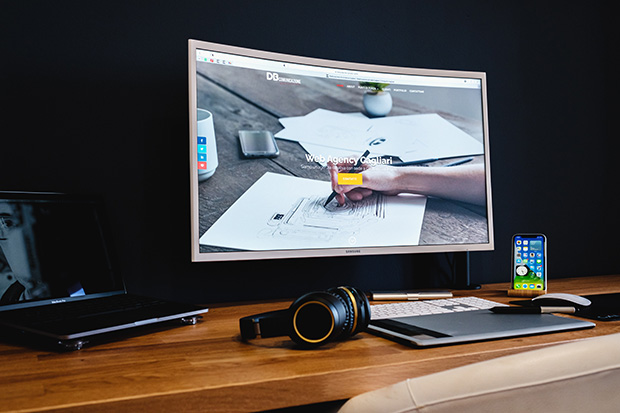Web Designer Education: What You Need for Career Success

Source: https://unsplash.com/photos/black-flat-screen-tv-on-brown-wooden-table-Nzmyp6LsgNM
The field of web design is a vibrant and ever-evolving landscape where creativity meets technology. Understanding the right educational path is crucial for students embarking on this journey.
It's a unique blend of artistic talent and technical know-how, requiring a balance between aesthetic sensibility and a firm grasp of web technologies. Choosing the right educational path is more than just learning the basics; it's about building a robust foundation to support and nurture your career growth.
This could mean formal education, self-guided learning, or both. Some students even pay for research paper to supplement their understanding, and their learning comes from hands-on experience and practical application. Now, let’s dive deeper into the topic of web designer education and what’s needed for career success.
Core Educational Pillars in Web Design
A comprehensive education in web design is anchored in a few key areas. First and foremost is an understanding of fundamental design principles. This includes color theory, typography, layout, and user experience (UX) design. These principles are the bedrock of effective web design, dictating how websites look and feel to the end user.
Then comes the technical aspect. This involves acquiring skills in HTML, CSS, JavaScript, and various design tools. Initially, this can seem overwhelming, but it's crucial for anyone aspiring to be a web designer. Thankfully, a wealth of resources, from online courses to tutorials, are available to help students navigate these technologies.
Another critical aspect is mastering responsive and adaptive design. In today's world, where mobile devices are ubiquitous, designing websites that function seamlessly across various devices and screen sizes is imperative. It's a skill that boosts a designer's portfolio and is also a requirement in the modern digital landscape.
Gaining Useful Experience
While theoretical knowledge forms the backbone of a web designer's education, practical experience is where these skills are truly honed. Building a diverse and rich portfolio is one of the most effective ways to gain this experience. This portfolio is more than a collection of work; it's a testament to a designer's journey, showcasing their skills, style, and versatility.
Internships and real-world projects play a pivotal role in a web designer's education. They provide a glimpse into the industry's workings, allowing students to apply their skills in practical scenarios, understand client needs, and experience the lifecycle of a project from inception to completion.
Continuous learning and adaptation are key in a field as dynamic as web design. This means keeping abreast of the latest trends, technologies, and design methodologies. Whether through online courses, workshops, or self-study, staying relevant and updated is essential for long-term success in this field.

Source: https://unsplash.com/photos/turned-on-macbook-pro-beside-gray-mug-Px3iBXV-4TU
Expanding Your Skill Set
Beyond the basics, a well-rounded web designer must be familiar with advanced skills like animation, interactive design, and basic programming. Learning these skills not only enhances your ability to create dynamic and engaging websites but also sets you apart in the job market.
Animation, for example, can bring a website to life, making it more interactive and engaging for users. Interactive design focuses on how users interact with your website, ensuring a seamless and intuitive user experience. Understanding the basics of programming, even if it's just JavaScript or a CMS like WordPress, can significantly broaden the scope of what you can achieve as a designer.
The Importance of User Experience (UX) and User Interface (UI) Design
In web design, UX and UI design hold paramount importance. UX design focuses on the overall feel of the experience, while UI design is about how the website interfaces with the user.
A strong education in web design will cover these aspects in detail, teaching you how to create websites that are not only visually appealing but also user-friendly and accessible. This includes understanding user research, creating personas, designing wireframes and prototypes, and testing designs for usability.
The Role of Soft Skills
Soft skills like communication, problem-solving, and teamwork are just as crucial for web designers. As a designer, you'll often work in teams, collaborate with clients, and need to articulate your ideas clearly. Therefore, developing these skills can be as important as your technical abilities. Courses that include group projects or client interactions can provide valuable experience in this area.
Keeping Up with Trends and Technologies
The digital landscape is always changing, and a good education in web design will teach you how to stay up-to-date with the latest trends and technologies. This could mean learning about new design tools, understanding the latest web standards, or exploring emerging fields like virtual reality or artificial intelligence in web design. Being proactive in learning and adopting new technologies will keep you relevant and in demand as a professional.
Networking and Building Professional Relationships
Networking is a key component of a successful career in web design. This involves connecting with other professionals in the field, attending industry events, and possibly joining design organizations. These connections can lead to job opportunities, collaborations, or valuable mentorships. Educational programs that offer networking opportunities or have active alum networks can be particularly beneficial in this regard.
Real-World Applications
Understanding how to apply your skills in real-world scenarios is fundamental. This might involve working on live projects for clients, participating in internships, or even freelancing. Such experiences teach you about working within deadlines, managing client expectations, and the practical aspects of running a web design business if you choose to freelance.
Preparing for the Job Market
Finally, a comprehensive education in web design should also prepare you for the job market. This includes guidance on how to create a compelling resume, prepare for job interviews, and present your portfolio effectively. Many educational programs offer career services or partner with companies looking to hire new talent, which can be a significant advantage when starting your career.
Final Thoughts
The journey to becoming a web designer is both challenging and rewarding. It's a path that requires a blend of creativity, technical prowess, and an unending appetite for learning. Whether you're just starting out or pivoting to a new career, the education you pursue in web design sets the stage for your future success.
Remember, it's not just about creating visually appealing websites; it's about crafting experiences that resonate, engage, and inspire. With the right educational foundation, your journey as a web designer can be as limitless as your imagination. Stay curious, embrace continuous learning, and let your creativity chart the course to a fulfilling career in web design.
Copyright © . All Rights Reserved